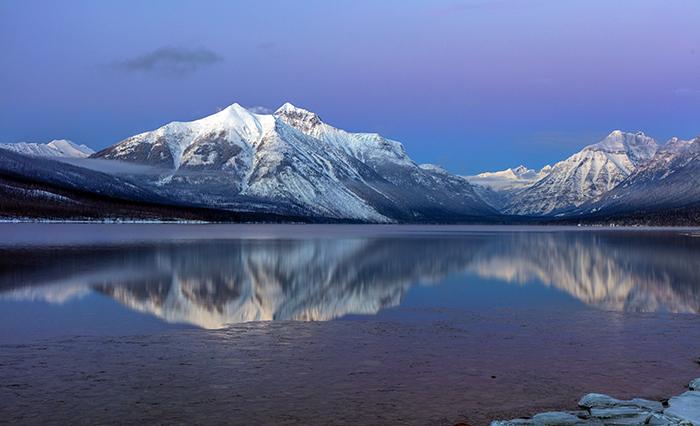
Blue hour at Glacier National Park / Rebecca Latson
Depressed by the humid, 78-degree January weather here in southeast Texas (I like my winters to look and feel like winter), I decided to take a nice little January MLK-weekend jaunt with my cameras and my snowshoes out to Glacier National Park. In sub-zero temps. My kind of photographic trip!
Sure, I’ve photographed in the snow before, but never within the below-freezing heart of winter in this particular park. I learned quite a few things via first-person experience, and I’d like to share these findings just in case any of you ever consider embarking upon a winter photography trip of your own to this national park (and, you should).
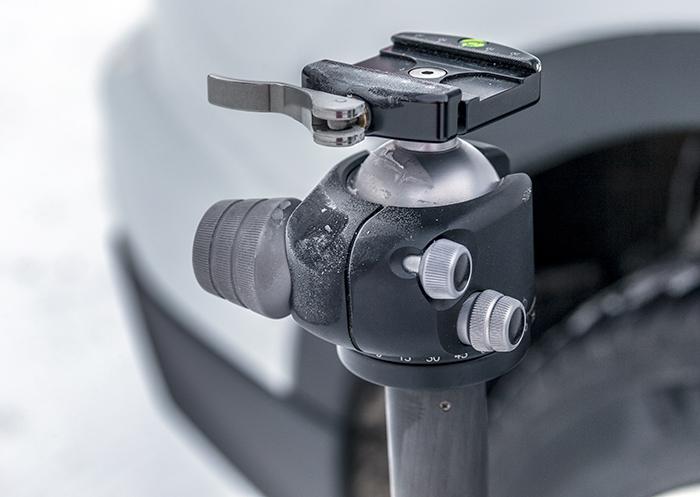
Cold enough for frost on the tripod, Glacier National Park / Rebecca Latson
- During mid-January, Going-to-the-Sun Road (GTTS) is closed between the Lake McDonald Lodge on the western side of the park to St. Mary on the eastern side. Really harsh weather might even mean closure of the road right at the West Glacier park entrance as well as anywhere along Highway 2 heading toward East Glacier. Road closures do not mean, however, that you won’t see and photograph some amazing scenery at either end of the park.

Lightly frosted, Glacier National Park / Rebecca Latson
- For a day of freezing Glacier National Park photography, dress in layers: a thermal base layer (like polypropylene or some other new-fangled fabric), a fleece or wool pullover or jacket, an insulated coat, a neck gaiter, a warm hat (wool or fleece), insulated pants, warm socks, water-resistant boots, and definitely gloves or mittens (which might keep your hands warmer because all of the fingers are together). Regarding gloves, I don’t like wearing them when operating a camera because I can’t feel or get a good grip on the controls. I knew I needed them, though, so I compromised with a pair of cashmere fingerless gloves. I still have all of my digits, which means the cashmere kept away the frostbite (OK, handwarmers helped with this too - more about those further down). In retrospect, I would have liked something a little bit thicker, but still fingerless. There’s a brand of glove by AquaTech called “Sensory Gloves” that look interesting, but the reviews are mixed. These gloves consist, in part, of neoprene, and there are holes cut into the thumb and index finger to allow the wearer a better grip on camera controls. If any of you readers have or plan on purchasing this brand, I'd be interested to know what you think.
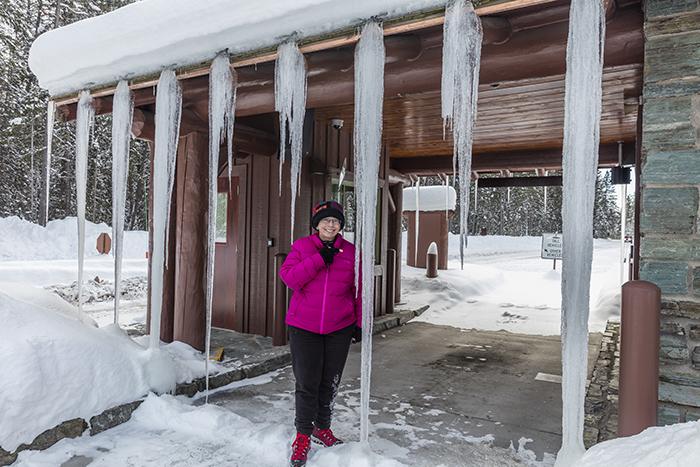
Some very long icicles at the West Glacier entrance, Glacier National Park / Rebecca Latson
- Pack some air-activated handwarmers. The airline on which I flew (United) allows them into both checked and carry-on baggage. A friend purchased some as a Christmas gift for me, and I stuck them in my jacket pocket. The heat lasted several hours and was a welcome comfort against the biting cold.
- Regarding walking around on the snow: You really should wear snowshoes or cross-country skis. Snow-carpeted ground is full of hidden pitfalls, and it’s very easy to “post hole” (step through snow down to your knee or thigh), causing an injury that could really ruin your trip. I LOVE my MSR Lightning Ascent snowshoes. As I researched brands, I came to the conclusion that ease of attaching bindings to boots in freezing weather was every bit as important as keeping boot firmly affixed to snowshoe. My arthritis-warped hands were able to quickly and securely strap my boots into the bindings. Also, think about a pair of gaiters to keep the knee-to-ankle area of your pant legs dry.
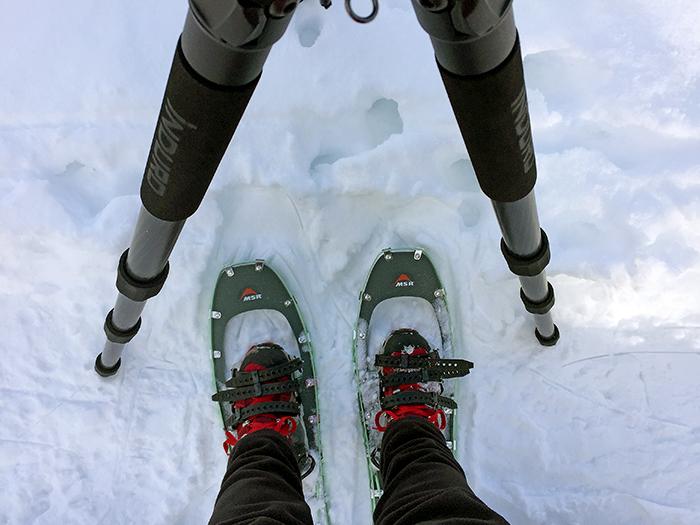
My MSR Lightning Ascent showshoes in Glacier National Park / Rebecca Latson
- Take your time snowshoeing/cross-country skiing. Look at the beauty around you. Be observant or else you might neglect to spot nearby camouflaged wildlife. Because I was more interested in watching my step rather than the scenery, I almost missed this doe feeding on the lichen not more than 15 feet away from me just off the side of the road.
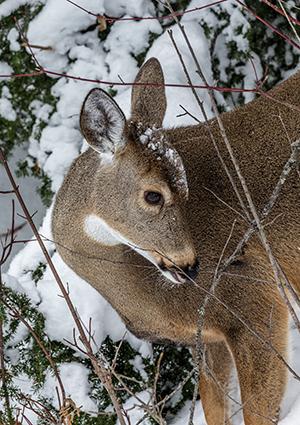
Snow on her head, Glacier National Park / Rebecca Latson
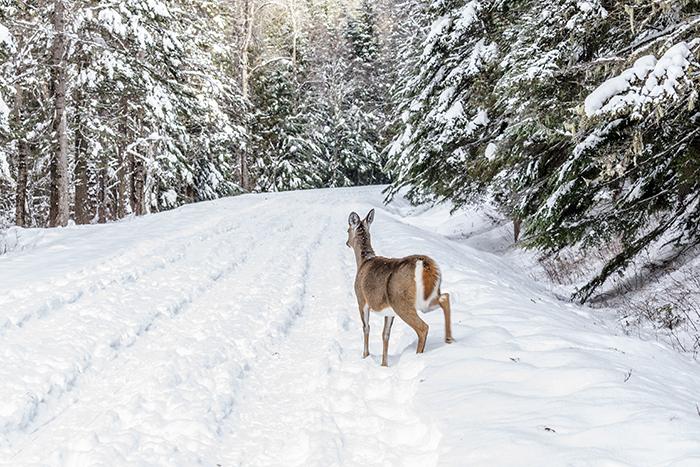
Deer in the road, Glacier National Park / Rebecca Latson
- Take along an energy bar and water. Eating carbohydrates gives you the energy to stave off hypothermia, and even though you might not feel thirsty, your body is losing moisture via sweat as well as the simple task of breathing (frosty breath means escaping moisture).

Little birdies pecking around, Glacier National Park / Rebecca Latson
- While most cameras nowadays are relatively weather-resistant (not waterproof, but weather-resistant), winter extremes may damage your camera if you are careless. Cameras can suffer interior condensation when exposed to sudden changes between heat and cold. After experiencing -4 degree Fahrenheit weather during my first day in the park, I understood the importance of gradually acclimating the camera to temperature differences. Upon returning to the vehicle, I’d either place the camera in a really large Ziploc bag or I’d zip it up in my camera backpack, allowing it to slowly adjust to the warmth of the SUV. Once in the hotel room, I’d keep the camera in the bag a bit longer before opening it to remove the memory cards.
- Batteries in very cold weather run out of juice quickly, so play it safe and bring along spares for your day outside. Don’t forget to pack a charger for those camera batteries and your phone. Smartphones really don’t like super-cold weather and might shut down right in the middle of your video capture (seriously).
- Carry a circular polarizer filter and a graduated neutral-density (grad ND) filter in your pack. Sometimes, one or the other or both are just what you need to reduce snow glare, enhance color saturation, bring out the texture in the clouds, and adjust the exposure difference between extreme light and dark horizons within a composition. Although the day was dark at times, as exhibited in the photo below, the mountain in the background still remained overexposed, appearing as a white blob on my LCD screen until I utilized my grad ND filter to remove some of the overbrightness.
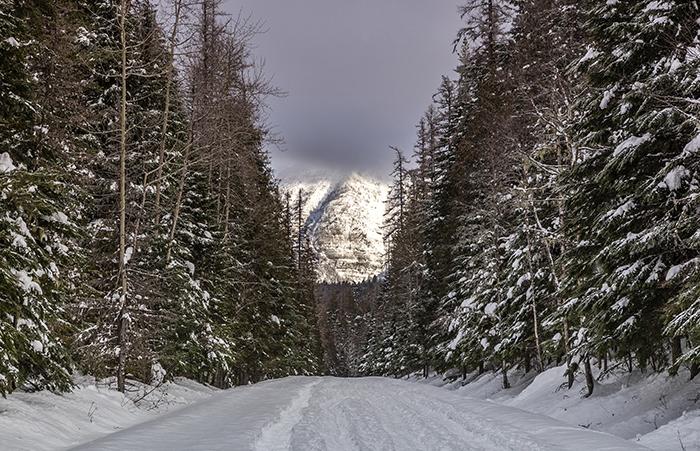
Going-to-the-Sun Road in the winter, Glacier National Park / Rebecca Latson
- Use your lens hood if it’s snowing. I did with my 100-400mm telephoto. The hood will protect the lens front from getting wet, and you won’t have to use that invaluable microfiber cloth you remembered to pack to continually wipe away melting snowflakes off the front of your lens. If you don’t want to use a lens hood, then at least keep the lens cap on when not in use or cover your camera and lens with a rain cover. Online camera sites like BH Photo and Adorama carry all sorts of protective covers like Vortex Media’s SLR Storm Jacket ($27 on up, depending upon size), LensCoat's Raincoat ($59.99 on up), or one of the Ruggard-brand rain covers (less than $6 on up to $70).
- During your photo editing, you might observe your snow photos looking a bit on the blue side or maybe a little “murky” or dull gray. Rather than take up a lot of space explaining ways to mitigate that color issue, I thought I'd instead include the link to BH Photo's blog site, which has a great little article with tips for snow photography and achieving the right white.
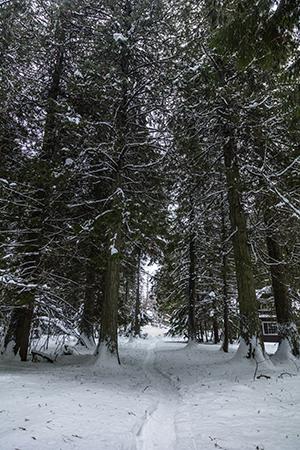
A snow path through the tall trees at Lake McDonald Lodge, Glacier National Park / Rebecca Latson
- Because most of GTTS Road is closed during the winter, why not continue to revisit the same spots during different times of the day? You will be surprised at how much a scene can change from dawn to dusk.

Morning at Lake McDonald, Glacier National Park / Rebecca Latson

Sunrise at Lake McDonald, Glacier National Park / Rebecca Latson

Afternoon at Lake McDonald, Glacier National Park / Rebecca Latson
I am stoked to have started my photographic 2017 with some stunning winter imagery captured in an incredible location. I think you will feel the same if you decide to embark upon a deep-winter trip into Glacier National Park. I hope these bits and pieces of advice are helpful in getting you on your way there, sooner rather than later.
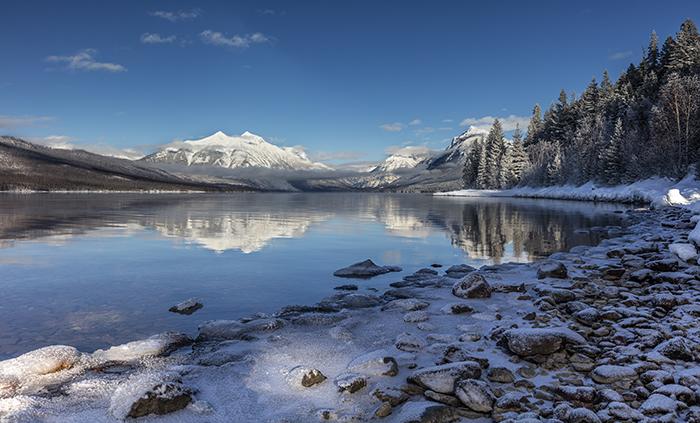
Heaven on Earth, Glacier National Park / Rebecca Latson



Comments
Excellent tips. Love the examples of Lake McDonald at different times of day.
When can we expect more Armchair Guides? Hint: We'll be in the Blanding area of Utah -- Canyonlands, Valley of the Gods, etc. -- in a few months in case you want to churn one out real fast. ;>)
Hello Rebecca, some really nice photos of lake Mcdonald. would like to do some night photography there in the future, i was there twice in 2014, early April and the weather was not good for photos and was back in August with 14 of my friends. They have a program there now that has a large telescope in the parking lot at Agar visitor center along with some photographers to share the magic and plan to take part in that soon. Thanks for you"re couragous attitude to explore different climates. Dewayne
Thank you, Dewayne, for your kind words. I didn't know about the telescope - that sounds really cool and I'll bet it's amazing on a clear night.
Hi There, Amarillobymorning - Thanks for the kind words. As for any armchair guide in the near future, I have my national park visits all mapped out for this year and I'm afraid I won't be in Utah this year. The places you plan on visiting certainly sound like a good stop for me at some point in time, perhaps in 2018 (I have visited Canyonlands, but only for a day). Enjoy your travels!
Rebecca:
Very impressive. I love the variety of lighting situations ... and of course, the subject matter (GNP, itself). I was raised as an "Army brat" and had the privilege of seeing several of the national parks as a "youngster" (and a few more as I've gotten to an "oldster" now), but GNP has been on my "dream list" for quite some time. Even the name of the main road thru GNP, Going to the Sun Highway, has captured my imagination. Maybe some day ... sigh. In the mean time, thanks for you sharing your shots. It does help me to know that places like this are still out there. randy
Glacier is probably my favorite National Park. I've been there three times, but never in winter. Great photos Rebecca. I absolutely loved the bottom one.